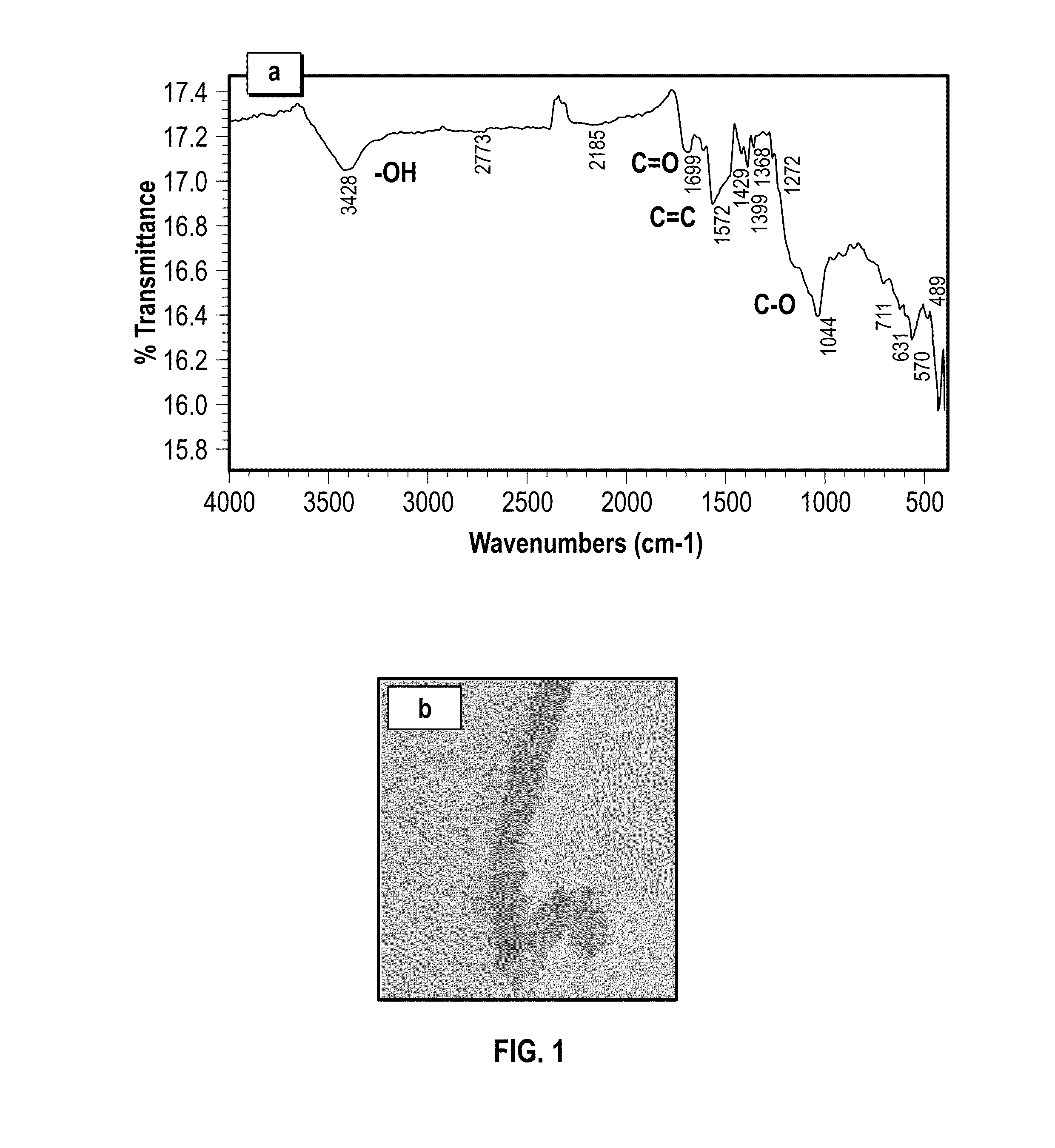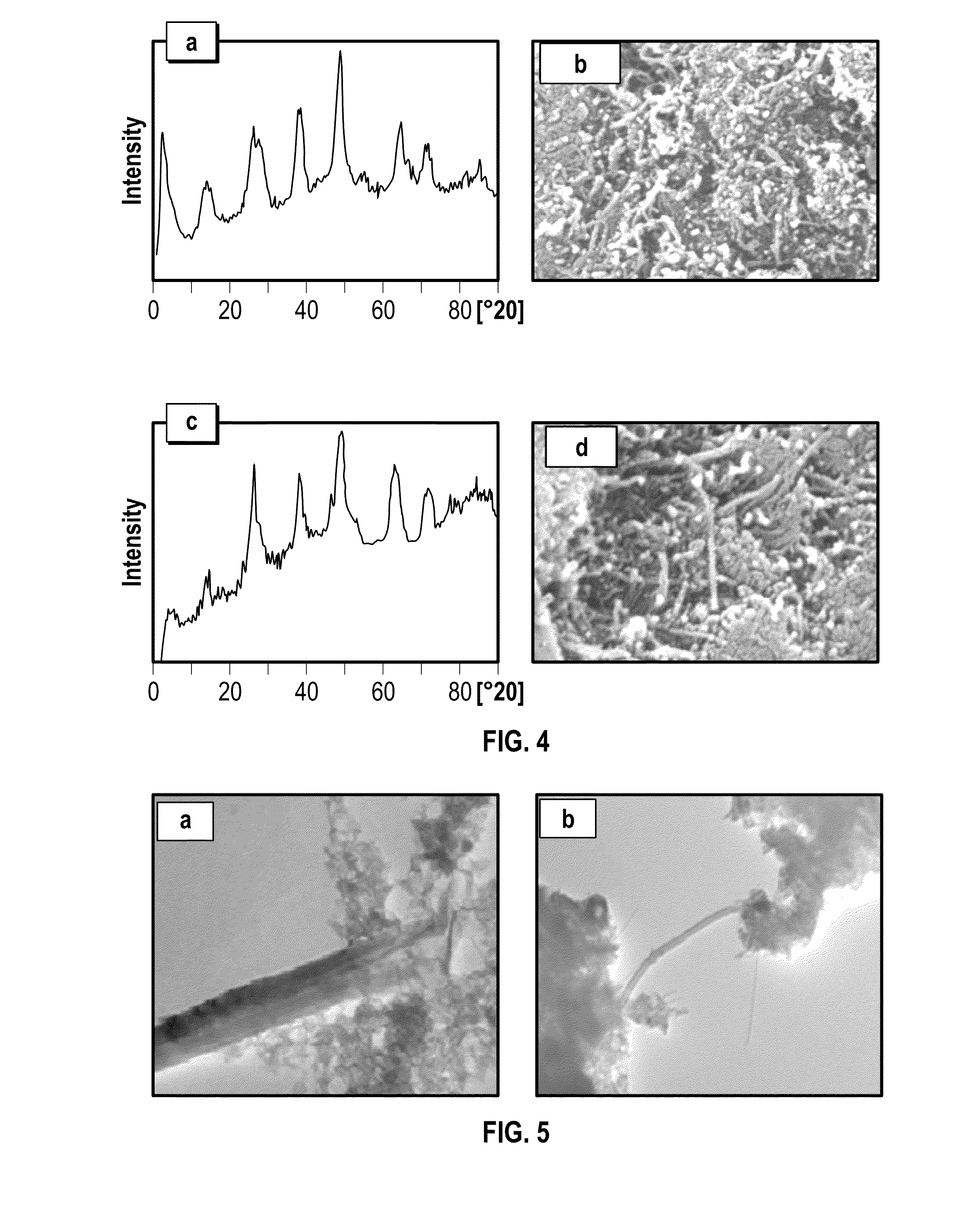Compositions and methods employing multi-walled carbon nanotube-based nanohybrids and applications thereof in oil recovery
- Summary
- Abstract
- Description
- Claims
- Application Information
AI Technical Summary
Benefits of technology
Problems solved by technology
Method used
Image
Examples
example 1
Preparation of Open-Capped MWCNTs
[0058]In the present invention, the supplied MWCNTs are preferably prepared by a chemical vapor deposition (CVD) method, which is known in the prior art, and, after thermal treatment for removing the amorphous carbon, the MWCNTs are treated with HCl and HNO3 for removing the metal oxides.
[0059]As described hereinabove, it is necessary to open the caps of MWCNTs for the preparation of the MWCNT-SiO2 and MWCNT-Al2O3 nanohybrids. Therefore, about 2 g of MWCNT was added to a mixture of about 160 ml distilled water and about 140 ml nitric acid, and the admixture was refluxed for about 18 hours. After filtration and neutralization with distilled water, the resultant sample was kept in an oven to dry.
[0060]With reference now to FIG. 1 of the DRAWINGS, divided into an upper portion, part a, and a lower portion, part b, the COOH group formation on the MWCNTs structure is proved by the illustrated FT-IR spectra and TEM image of the modified MWCNTs. As shown, t...
example 2
Synthesis of the MWCNT-Silica Nanohybrids by a Sol-Gel Method Under Ultrasound Irradiation
[0061]In this embodiment example, about 7 ml tetraethyl orthosilicate (TEOS) was dissolved in about 35 ml ethanol, and put in ultrasonic bath for about 20 minutes afterwards, after which about 1 ml distilled water was added to the mixture and a suitable amount of the aforementioned open-capped MWCNTs, prepared as described in connection with EXAMPLE 1 hereinabove, was added and stirred for about 10 minutes. Then, about 2 ml ammonia solution (25%) was added into the reaction mixture at a rate of about 0.2 ml min−1 as the reaction catalyst. Thereafter, the obtained mixture was sonicated for about 3 hours. Finally, the product was filtered and washed with distilled water and ethanol and dried in the oven at 60° C.
[0062]With reference now to FIG. 2 of the DRAWINGS, divided into four images, parts a, b, c and d, respectively, there are shown a pair of X-Ray Diffraction (XRD) patterns and SEM images ...
example 3
Synthesis of the MWCNT-Silica Nanohybrids by a Sol-Gel Method
[0064]Here, about 0.7 g of MWCNTs was added to about 3 ml sodium silicate in order to produce MWCNT-SiO2 nanohybrids by the sol-gel method. The open-capped MWCNT was kept in about 50 mL of 2.5% hydrochloric acid at about 80° C. with a stirring rate of about 300 rpm until it was fully distributed. Afterwards, the sodium silicate solution was transformed by dripping into the mixture with the rate of about 10 drops per minute until forming a viscous and cloudy gel. Finally, the obtained product was dried at about 80° C. for 24 hours. The XRD pattern, SEM image and TEM image of the prepared MWCNT-SiO2 nanohybrid pursuant to the teachings of the present embodiment example are illustrated in the aforedescribed FIG. 2, parts c and d, and FIG. 3, part b, of the DRAWINGS, respectively. The silica nanoparticles insertion into the MWCNTs structure can be observed from the XRD pattern shown in FIG. 2, part c. In addition, the nanopart...
PUM
 Login to View More
Login to View More Abstract
Description
Claims
Application Information
 Login to View More
Login to View More - R&D
- Intellectual Property
- Life Sciences
- Materials
- Tech Scout
- Unparalleled Data Quality
- Higher Quality Content
- 60% Fewer Hallucinations
Browse by: Latest US Patents, China's latest patents, Technical Efficacy Thesaurus, Application Domain, Technology Topic, Popular Technical Reports.
© 2025 PatSnap. All rights reserved.Legal|Privacy policy|Modern Slavery Act Transparency Statement|Sitemap|About US| Contact US: help@patsnap.com



